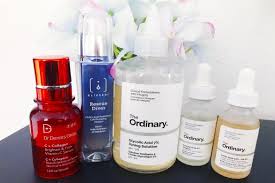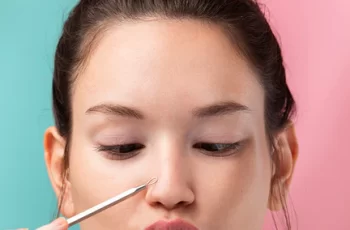Can I Mix Azelaic Acid with L-Ascorbic Acid?
When it comes to A-list skincare ingredients, azelaic acid and L-ascorbic acid are both VIPs of the beauty world. Don’t let the overly scientific names confuse you, these are two ingredients that you will already know about, and chances are, they are already in the formulations of some of your skincare products.
As I have mentioned in previous blog posts, we can often get carried away and go overboard when applying skincare products. It’s easily done, but can sometimes lead to unwanted flare-ups in redness, irritation, and reactions. This brings us to today’s topic and with any luck, we’ll make things a lot clearer. So, with that in mind, let’s dive into finding out more about whether you can mix azelaic acid and L-ascorbic acid together.
What is azelaic acid?
Azelaic acid is a naturally occurring acid in the body and is derived from barley, wheat, and rye. Known to effectively treat acne, breakouts, and other blemishes by clearing out the pores of bacteria build-up whilst encouraging the skin cell turnover to ensure the skin heals quicker and minimises the appearance of dark spots and uneven skin tone.
Often found in over the counter products, but many favour to opt for a prescription formulation due to the percentage being higher. This is because azelaic acid can take some time to deliver its results as it must be used in the correct way to ensure it doesn’t lead to causing burning to the skin, dryness, and peeling. To avoid this, always ensure you have checked with a doctor or dermatologist you are using the correct formula and percentage for you and your skin.
If you wanted to find out more about azelaic acid, check out our dedicated blog post about how it works on the skin.
What is L-ascorbic acid?
L-ascorbic acid, also known as vitamin C, is a skincare ingredient which is a favourite amongst dermatologist and skincare fans. For good reason due to the amazing benefits, it can deliver to the complexion. Packed with antioxidants it is one of the most potent ingredients to combat free radicals, such as UV light, pollution, and other environmental aggressors. You will find that the overall look and feel on the skin appears brighter, reduced signs of fine lines and wrinkles with a more even finish and improved texture.
There is more to find out about l-ascorbic acid in our dedicated blog post, so don’t forget to check that out.
Can you use azelaic acid and l-ascorbic acid together?
Yes, you can, but ensure you use them in correct way to give these powerhouse ingredients optimal chance of delivering results whilst avoiding any unwanted side effects. There are a few different ways you can use azelaic acid and l-ascorbic acid together, here are some examples of the most effective ways of reaping the rewards.
Allow 15 minutes in between applications
Ensuring you allow about 15 minutes between applications will help the skin pH level to rebalance. This is important since both l-ascorbic acid and azelaic acid both have lower pH levels meaning they are both more acidic. Layering them on top of each other will be too much for the skin and cause irritation as well as preventing each of these powerhouses to perform their benefits on the face.
Alternate the time of day you apply each ingredient
Many find that alternating the time of day they apply these ingredients is the best way of ensuring each ingredient performs on the skin. Thanks to the luminous finish vitamin C leaves on the skin, and the ample amounts of antioxidants, many favour to apply serums enriched with the acid during their morning routines. Following this with azelaic acid in the evening helps to replenish and rejuvenate the skin whilst you sleep and bypass any irritation caused from overloading the skin.
Alternate the days you apply each ingredient
If you preferred to use azelaic acid and l-ascorbic acid in your morning routine, you can alternate the day you apply them on the skin. This ensures you benefit from both ingredients without any concerns with causing irritation to the skin. One important point to remember, due to both acids causing the skin to have increased photosensitivity. Always apply a daily SPF of 30 and above to keep the skin protected from exposure to UV light and other environmental aggressors, even on days that appear overcast and forecasted rain.
There you have some of the most common ways of using l-ascorbic acid and azelaic acid together. If you still have some concerns with using these potent powerhouses in your routine, consult with a doctor or dermatologist for the most effective way of introducing these ingredients in your routine.
Can I use azelaic acid and vitamin C at the same time?
Yes, technically you can use vitamin C and azelaic acid at the same time, however, this is something I would avoid. Although it is known that using both ingredients is perfectly safe, you can often have too much of a good thing. As I have already mentioned, pH levels are often the cause for skin irritation and is something that can happen very easily. With our skin having a pH level of about 4.7 on average this “neutral” level it can often disrupt more acidic formulations causing them to become unable to deliver their optimal results.
To ensure you avoid all this trouble, I suggest you use both ingredients using the different options I have mentioned above. If you wanted to know more about using vitamin C and azelaic acid together, there is another blog post about how to use them over on The Beauty Insiders.
Another way of ensuring your skin will be happy with both ingredients is to perform a patch test for 24 hours before applying them all over the face. Take a 10p size amount of product and apply it on the inside of the forearm, leave it for 24 hours and if there is no sign of irritation or redness, you are good to go.
There you have a little more information about mixing azelaic acid and l-ascorbic acid together. Don’t forget if you have any further skincare questions, you can come, and follow us over on the Procoal Instagram, there’ll be a skincare expert waiting to answer your questions in the direct messages.
DQH Knowledge drop: In your 20s, your skin cell turnover decreases. (Cell turnover is a key component in keeping your skin youthful.) You know what else slows down? Your collagen production. Starting in your 20s, collagen decreases by about 1 percent per year. Should you want to prevent fine lines and wrinkles, start by eliminating behaviors that contribute to premature aging. “If it’s bad for you, it’s bad for your skin,” says dermatologist Michel Somenek.
“Cigarette smoking reduces blood flow to the skin and causes premature wrinkling and a dull skin texture. Making the repeated pursed motion to inhale can also cause smoker’s lines. Alcohol and recreational drugs are toxins for the skin that damage its cellular structure and DNA,” Somenek tells us. “The faster you eliminate vices while you are young, the better chance your skin and body have to recuperate.” Also, adopting an anti-aging routine in your 20s is key. After all, the best offense is a good defense. We spoke to Somenek and experts Joshua Ross and Audrey Kunin to find out more.
Keep reading for the best anti-aging products for your 20s, according to skincare professionals.
Sunscreen
“We all know that the sun is the number one cause of skin aging and starting the prevention in your 20s is very important,” Ross says. “The majority of your sun damage won’t start to appear until you’re in your 30s, so don’t wait until you see it surface or you’ll be behind the curve. Stay ahead of it with a good-quality zinc-based sunscreen worn daily.”
Farmacy Green Defense Daily Mineral Sunscreen
An invisible sunscreen with SPF 30, plus botanical extracts meant to protect skin with tons of antioxidants. Bonus: It’s clean and fine to use under makeup.
Bareminerals Complexion Rescue™ Tinted Moisturizer Broad Spectrum SPF 30
Although we recommend you use your SPF and moisturizer separately, we also understand moments when you don’t have time or energy for that extra step. For those times, this bareMinerals moisturizer is a great thing to have on hand.
Vitamin C Serum
“A great introduction to anti-aging is to start with a vitamin C serum in your morning skincare routine,” Ross says. “It’s a powerful antioxidant that will neutralize free radicals and brighten the skin.” He adds that it’s a great way to counteract the effects of the sun’s harmful rays, which, as previously mentioned, are among the biggest causes of premature aging.
Drunk Elephant C-Firma™ Vitamin C Day Serum
The Drunk Elephant C-Firma is a lightweight serum that promises to give skin a glow by combining the brightening powers of vitamin C with ferulic acid, l-ascorbic acid, and vitamin E. The included sodium hyaluronate is meant to replace hydration loss, so you shouldn’t have to deal with any irritation.
Sunday Riley C.E.O. Rapid Flash Brightening Serum
This potent serum is jam-packed with vitamin C (15 percent, to be exact), which means it’s a potential superstar at both brightening skin and dousing it in antioxidants.
Peptides
Using peptides on your skin has many benefits, says Somenek. “The skin barrier is what defends the body against pollution, UV rays, bacteria, and toxins. It can be damaged by several everyday factors. Using topical peptides aids in building a stronger barrier,” he says. “Peptides comprise elastic fibers, which are a type of protein. These fibers help to make skin appear taut and firm. Peptides can also help repair damaged skin, relieve inflammation, and even out skin tone. Some peptides can kill acne-causing bacteria that is common in 20-somethings.”
Kunin agrees, saying, “Peptides are an excellent entry point for supporting collagen.” She recommends looking for face and eye treatments that contain these collagen-boosting powerhouses.
Charlotte Tilbury Magic Eye Rescue Cream
This Charlotte Tilbury super-emollient eye cream has a base of coconut oil and shea butter (read: it’s incredibly hydrating). Botanicals plus peptides are meant to help reduce dark circles and boost collagen, respectively.
This creamy moisturizer serves up potent collagen-boosting peptides and pycnogenol, and antioxidant-rich vitamin C. “Instead of sitting on top of the skin, peptides penetrate the outer layer so they go deep. The ‘signals’ they send tell the cells to produce elastin and collagen, which are needed for youthful-looking skin,” explains Somenek.
At-Home Peel Pads
Remember that skin cell turnover fiasco we talked about earlier? One way to help support it is by exfoliating. “Exfoliation is important to help keep skin fresh and luminous,” Kunin says. She recommends using at-home peel pads as an easy and effective way to exfoliate.
“The goal in your 20s is to fight the slowing pace of cell turnover. It is wise to use products that gently exfoliate, yet still remove oil and other impurities. Products that have Alpha Hydroxy Acids (AHA) or Beta Hydroxy Acids (BHA) are a good choice.”
According to Somenek, you should only exfoliate two to three times a week. “People of all ages are guilty of over-exfoliating and that can be too much of a good thing,” he says.
Dermadoctor Kakadu C Intensive Vitamin C Peel Pad
A few swipes of this Derma Doctor powerful peel pad promise to leave your skin glowing and smooth, thanks to the seven (yes, seven) types of chemical exfoliants, including AHA and BHA. It also contains vitamin C via Kakadu plum extract for added brightening and antioxidant protection.
KEY INGREDIENTS Kakadu plum extract is sourced from the Kakadu plum, a fruit grown in northern Australia. It contains vitamin C, which restores the skin’s natural barrier, increases collagen production, and soothes irritation.
Dr. Dennis Gross Skincare Alpha Beta® Universal Daily Peel Pads
These are the gold standard of peel pads, with a cult following and over 900 five-star reviews on Sephora. They’re easy to use and contain a blend of anti-aging exfoliating acids.
Emollient Night Cream
“In your 20s, you need to start upping the hydration in your skincare routine. You may have been cautious of over-moisturizing because of acne in your teens, but as you enter your 20s, your skin transitions and becomes drier,” Ross says. “I recommend an emollient night cream added into your evening skincare regimen.”
“Twenty-somethings need to make sure that they are not using creams that will clog their pores and cause excess oil production,” says Somenek. Opt for non-comedogenic products.
Cerave Skin Renewing Night Cream
One great choice is the CeraVe Skin Renewing Night Cream, which is a non-comedogenic night cream that leaves skin soft and glowy. It combines the moisturizing powers of ceramides and hyaluronic acid.
RoC Retinol Correxion Max Hydration Creme
“The best night cream ingredients contain retinol, benzoyl peroxide, and/or salicylic acid or hyaluronic acid. The goal is to moisturize, yet remove excess oil,” says Somenek. This Roc Retinol Correxion cream fits the bill as it contains both hyaluronic acid and retinol so it promises to moisturize while also being non-comedogenic.



